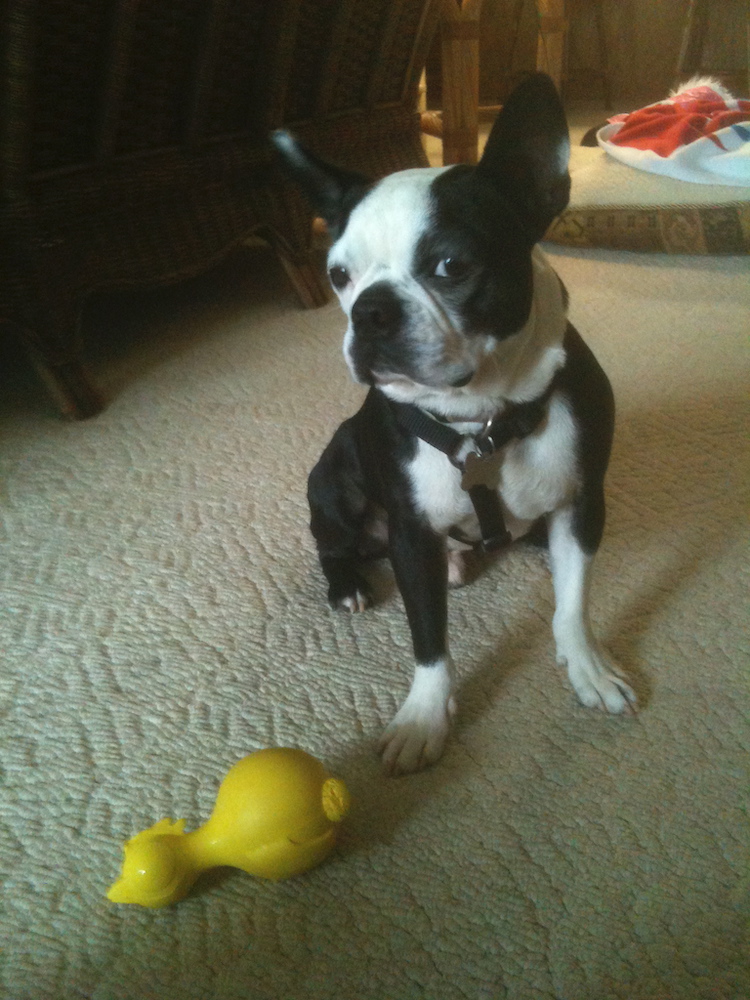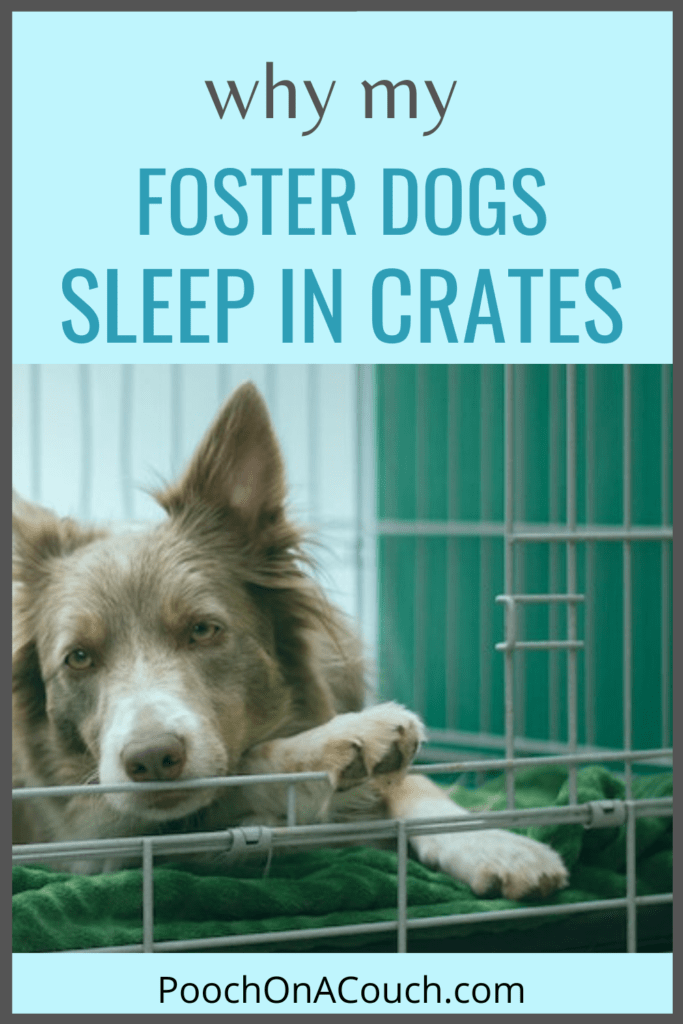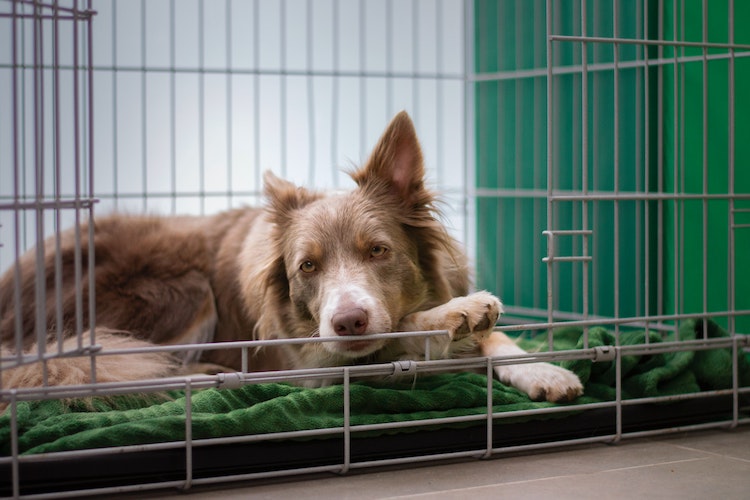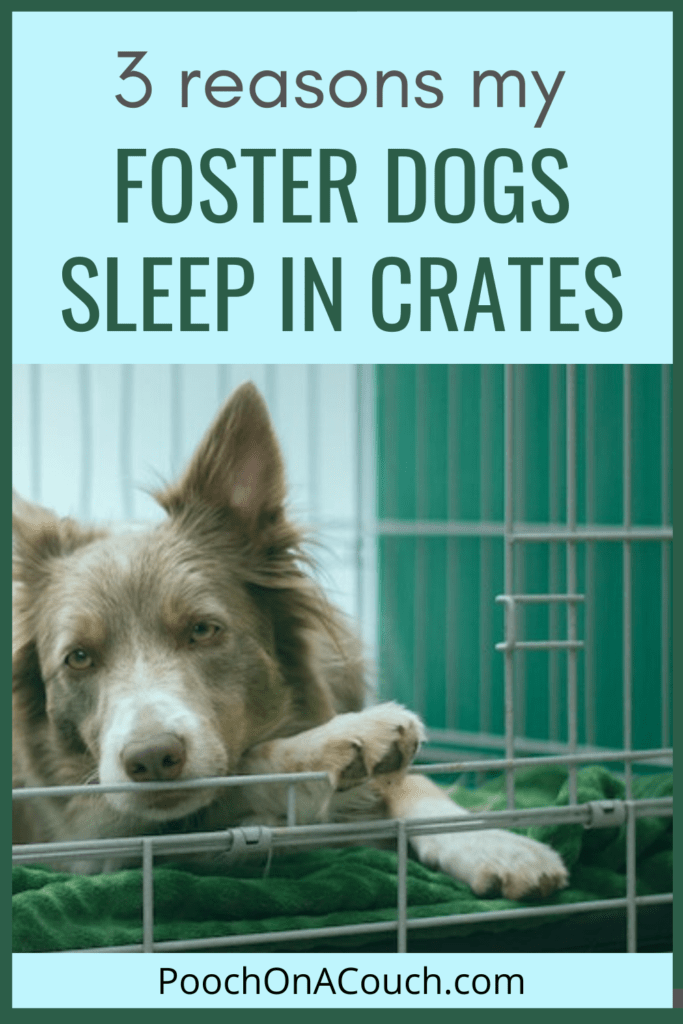My foster dogs sleep in crates.
My personal dogs sleep in the bed with me.
Unfair Treatment Of Foster Dogs?
Poor foster dogs, the step-pets? Nope. Not at all! Here’s why I do what I do:
- I’m improving their sleep experience and their overall health
- I’m reinforcing crate training.
- It’s a decision (to sleep in the bed or not) that I allow the adoptive family to make.
1. Asking My Foster Dogs To Sleep In Crates Will Improve Their Sleep Experience
Most foster dogs come from uncomfortable places: cold shelters with maybe a blanket to sleep on (or not), living outside and sleeping in a dark, dank doghouse (or no doghouse at all), living in breeder kennels, or living on the streets.
If they happen to be owner surrender dogs, their sleeping quarters are still varied or an unknown.
Many of my foster dogs arrive stressed, fearful, confused, depressed, and sick.
What these dogs need more than anything is sleep. Rescue dogs need to decompress, shed that stress, feel safe, recover from injury or illness, and experience a deep sleep night after night after night.
They cannot do that if they are competing for space in my bed.
They cannot do that if their sleep gets disrupted by me or another dog.
Their best rest comes from sleeping in a crate.

Bart
Bart was a beautiful, jet black and white Boston terrier, raised and adored by his mama and lived completely indoors until mama found a boyfriend who believed dogs belonged outside. At 5 years old, Bart was asked to sleep in a pen with a doghouse. Living in the country, there were plenty of brand new, scary, night sounds – wildlife, the weather, and those unknown sounds that are spooky. Bart was terrified. He lived that way for about a year and never adjusted to the noise.
When Bart arrived at my home, he couldn’t sleep. Every sound startled him – the HVAC unit turning on, the ice-maker in the fridge, the wind, creaks and crackles older houses make. When he startled, he panicked and woke the household.
I put Bart in a crate beside me, and I slept every night with my hand on his crate, my fingers dangling through the bars for weeks. Slowly, he startled less and less. About 6 weeks into his stay with me, he finally slept so hard he snored. That was a really good sound to hear. I think I cried.
Bart Benefitted From Sleeping In A Crate
I firmly believe that Bart needed the comfort, consistent routine, and safety of sleeping in a crate. Where he could settle. Where he could shed those fears. Where he could finally feel safe.
Had he been in the bed with me and my other dogs, he would have had to process all of that “new”, too.
I would have disrupted his sleep as I shifted my body’s position or another dog moved during the night. Why ask him to deal with that as well?
He needed his sleep to be restored.
Sometimes, oftentimes, I believe – the first thing our fosters need is simplicity. Less complicated environments. Less stuff to figure out all at once. I believe sleeping in a crate, in a quiet place, provides that simple, safe, uncomplicated, and comfortable space foster dogs need to begin their journey of recovery.
[Bart was adopted by a person who adored him. She had the joy of inviting him to sleep in her bed with her and he loved it! ]
2. Sleeping In A Crate Gives A Foster Dog Lots of Practice with Crate Training
I am a firm believer in crate training.
I believe every dog needs to know how to spend downtime in a crate. They need to know how to relax in a crate when I’m at home and when I’m away. During the day and at night. With another dog crated in the room and when they are all alone.
Bart, Emmy Lou, Maggie, Gus, Winston, Charlie, Chewy, Levi, Peggy, and all the rest spent every night with me in their crates, and know what?
They went in their crates happily and quietly, and in the morning were all well-rested and happy to say good morning.
All of those same dogs used their crates of their own choice during the daytime for open-door naps.
My job as a foster parent is to help my foster dogs become as familiar (and comfortable) with the crate as possible.
Emmy Lou is the only dog out of nearly 50 fosters that I couldn’t crate train, and yet – she was familiar with sleeping in a crate at night if all the details were to her liking. I was able to accommodate her wishes, and she willingly slept in her crate in my bedroom every night. It didn’t make sense to me to take a crate-aversive dog and not ask her to practice her comfort with nighttime crating part of her routine?
3. I let the adoptive family decide if they are going to ask their new pet to sleep in a crate.
Not everyone wants their pets to sleep in the bed with them.
Therefore, if my foster dogs sleep in crates already and the family plans for their new pet to sleep in a crate at night, my foster dog is going to have a less stressful transition to the new home and family. If I allow my foster dog to sleep in the bed with me and the adoptive family prefers the dog sleep in a crate, I’ve presented a more confusing situation for the dog, and the adoptive family has one more issue they have to train.
In short, families who want their pets to sleep in the bed with them appreciate the fact that they get to give their dog the special experience of joining them in the bed. Families who prefer their dogs to sleep in crates really appreciate that this training is already done in the foster home.
What About Jealousy and Behavioral Conflicts?
I’ve never experienced a problem with foster dogs acting out because they don’t get the same sleeping arrangements my dog does. My foster dogs don’t become depressed or feel excluded or treated second-best or anything. They are included in the regular day’s routine and get same-sies more often than they do not.
I’ve never had a problem with jealousy over sleeping arrangements.
I have experienced foster dog conflicts from time to time, (almost always over resource guarding) but no conflicts were attributed to hurt feelings because my foster dogs sleep in crates while my personal dog does not.
It’s not how dogs think.
Will you decide to ask your foster dogs to sleep in crates?
Before allowing your foster dog to pile up in the bed with you and everyone else, think about the long-range plans. What do you want your foster dog to know how to do before adoption? What is going to make your foster dog’s transition from your home to the forever home smooth with the least amount of stress/change/confusion possible?
Asking your foster dogs to sleep crates may help keep your foster dog well-rested, confident, and more flexible as they prepare to move to their new, forever home.

Popular Posts
- HOW TO CHOOSE A DOG RESCUE AGENCY
- ULTIMATE GUIDE TO FOSTERING: 10 SKILLS YOU NEED
- VOLUNTEER IF YOU CANNOT FOSTER





